
"Early and Modern Views of the City" was first posted on October 11, 2011 into Picasa and has been viewed by 6,432 viewers around the world since this public posting. Google has just announced the removal of all Picasa Images and Albums later in 2016. I therefore have saved all images, image data, and paragraphs as they were created many years earlier, and I will now rebuild this same content as Word Document pages in the months ahead. This content will now be held on a private server and these albums will be linked from my website -"Szombathely March 4, 1945 Project".
I thank you for your interest in this history over these many years, and I will work as diligently as I can in the months going forward to insure that these images and history will be available 24/7 in the years ahead. I will also correct any errors in the descriptions that may have come to light since the original "post-up" dates in all of my albums. I may also try to improve the quality of all photographs by using a cleaner version of the same image from my expanded collection here. Most of the text paragraphs should remain the same, however, if significant new information is now available, I will update those paragraphs as needed.
The Author. (6-1-2016)

A reconnaissance photograph of the city taken after the bombing of March 4, 1945. It was probably taken by a U.S. Army Air Corps aircraft shortly after the bombing, however, it has not been marked up with identifying marks or information that was usually added by the Intelligence Group S-2 back at the base in Italy. Damage to the Cathedral can be noted in the following close-up from this image. I have no other information about this image and would welcome any new additional insight from the readers.
A broad view of the city core can be seen from the railroad yards to the cathedral complex. The aircraft was over the city at a “clear” time without clouds and smoke from any burning structures in the city or at the railroad yards. Image Close-up Below: Shadow lines from the buildings indicate early afternoon sun. Altitude of the camera in the aircraft at this moment may have been the same as the bombing altitude of 22,000 to 25,000 ft. over the city (image undated).

A cropped and enlarged section from the preceding photograph (#1. Above)
References: A. The Seminary. B. The Cathedral. C. The Bishop's Palace. D. The Old City Hall. E. The bombed remains of an apartment complex. F. The Hangya Building on the city Főtér (or town square).
The Seminary (A) is at #1 János Szily Street, and next door was the "House of the Canon's" at #3 or #5 which received one or two bombs that killed the Papal Prelate Canon and Archbishop's Vicar's General, Dr. Lajos Kiss and the Cathedral's Canon, József Pintér. They had retired for lunch after the morning service at the cathedral in ‘45. The Seminary itself was spared from any direct hits, but may have sustained some collateral damage (unknown). I have no images here of this at this time.
The Cathedral (B) is well defined. The Crossing/Sanctuary received one bomb directly. This second aerial photograph shows clearly the sun shining on the floor of the Nave, and a round black hole in the roofing over the Crossing/Sanctuary. Two persons died in the Cathedral and two persons survived the heat, falling debris, the concussion and shrapnel from the bombs casing: An unknown woman at the small pulpit and a man hiding behind the St. Martin Altar.
A round black hole in a building's roofing may be a strong indication of a single bomb entering the Crossing/Sanctuary area of the Cathedral. The Bishop's Palace (C) was hit and its North wing was destroyed up to about the front wall of the Cathedral. Two Theological Students were killed in this section of the Palace. For more details on the bombing, see the Website: March 4, 1945 Szombathely Cathedral Project.

The image above is very similar to the Nave damage of the Cathedral. In the direction of the aircraft above, multiple bombs landing in a row would be a characteristic of a bomb pattern dropped from the same “bomb bay” of another aircraft overhead in the sky. The alignment of this damage at the apartment complex is the same as that of the cathedrals damage in the Nave. The Hangya Building below (the back patio area) also received a bomb on the patio deck of the building and it again was probably from the same aircraft in the bomb group that was heading to the railroad “the target for the day”.

(2006) Back Patio area of the Hangya Bldg. looking westward towards the back of the Apartment Complex with their back doors. This patio area was all reconstructed and at a later time was covered with perhaps a vinyl or rubberized sheeting glued to the concrete surface. In 2006 it was needing repairs again.
(Kodak 35mm. Slide)

The above image details more damage in and around the railroad yards. It may have been taken the following day by a reconnaissance single engine fighter (P-51) flying over the railroad yards. Bomb Damage assessments were often made of the effectiveness of the previous day’s mission and if a mission was judged “non-effective”, a second strike could then have been re-scheduled. This was not the case as the bomb craters above are clustered in and around the cemetery, trackage and overpass at the bottom of the image. (See sectional enlargement below).
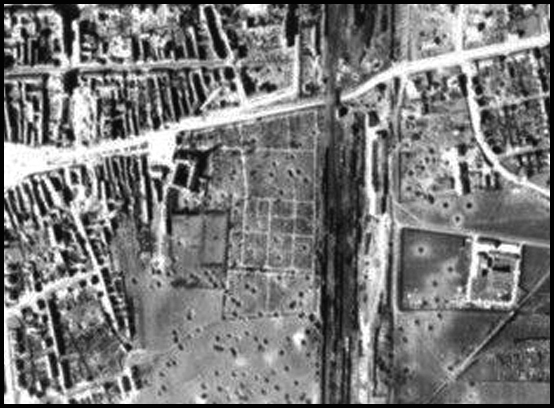
In the above sectional enlargement you can see the bomb craters that remained after the bombing in the cemetery behind the St. Martin’s Church (commonly referred to as the Dominican Church), along the trackage and beyond, and the overpass at Szent Márton utca. The spread of bomb craters below would indicate multiple aircraft above that were involved with this flyover, and also there were no identifiers on the image as to which bomb group this photograph could be associated with.

(The above image has been cropped and enlarged from a previous photograph #1a. )
The Cathedral is well defined. The Nave received 4-6 bombs and the Sanctuary received 1 bomb directly. This sectional photograph shows clearly the sun now shining on the floor of the Nave, the Cathedral is now more defined (via image manipulation here without a black hole in the roofing over the Sanctuary). Two persons died in the Cathedral and two persons survived the heat, falling debris, the concussions, and shrapnel from the bomb’s casings. An unknown woman at the small Pulpit, and a man who hid behind the St. Martin Altar did survive. In the above image, I have redefined the cathedral outline. This Post Bombing image was taken in the mid-late afternoon as the shadow lines on the pavement have now grown larger and the wing of the Bishop’s Palace has now been reduced. After several years of working in my image collection here, I believe that the Crossing Ceiling was not breached by a falling bomb, but there was indeed an explosion most forward in the Sanctuary that was high in the air-space showering shrapnel though out the Crossing, Transepts and forward Nave areas.
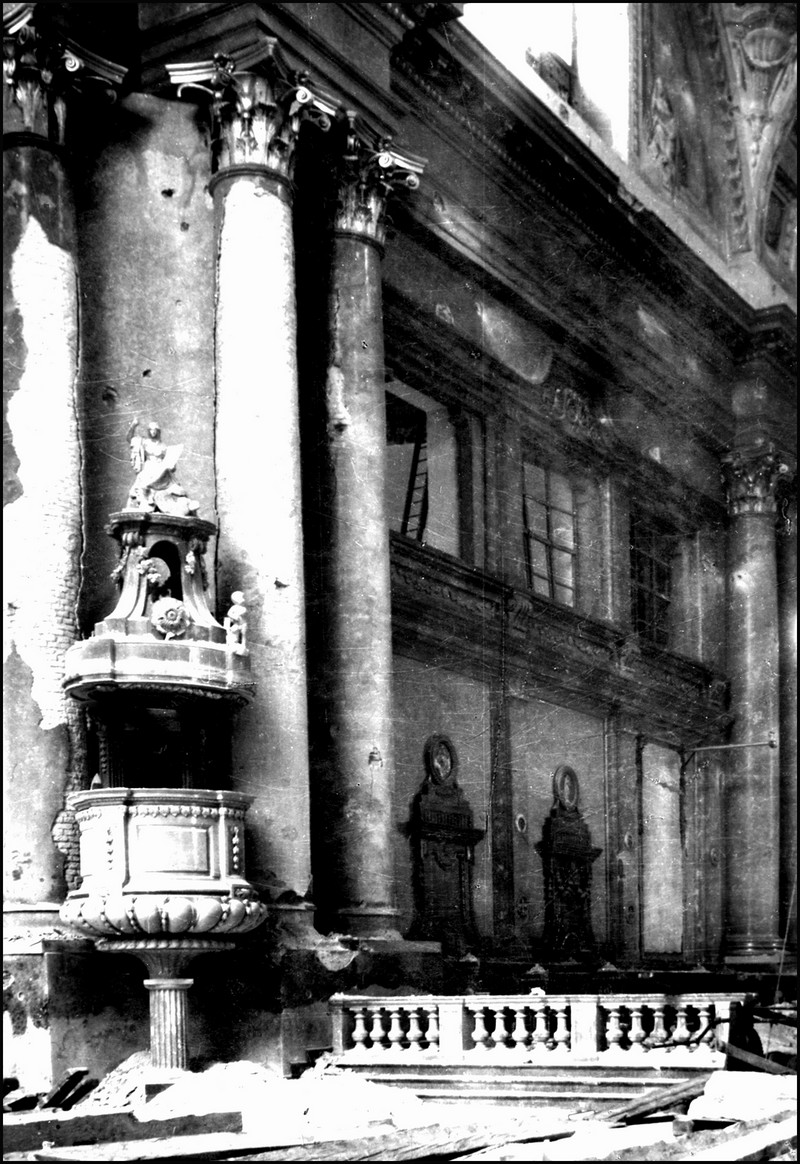
The Sanctuary bomb explosion was a millisecond earlier than those of the Nave. This single explosion damaged the Gloria and destroyed the Altar painting, while the resistant nature of the materials of the two white Marble statues, the High Altar, the Tabernacle, and the miniature Canopy adorned with two small cherubs (although one was disfigured), remained. The four Canon Stalls and painting of St. Paul were spared from major damage. The Baldachin over Bishop’s Cathedra was torn from its metal support and all glazing’s at the upper rooms on both sides were lost.

The hole in the Sanctuary ceiling looks quite large, (almost all of the Fresco is now missing, but this may have been done by the workmen early on to “safe up” the structure behind the Frescoed Ceiling in the attic space after the bombing.) Note the many “Boards” now across the opening in the photograph was probably meant to prevent an accidental “fatal” fall to the floor below.

(above) The right wall of the Sanctuary shows again the result of the bomb’s fragments damaging the finishes of the faux-marble surfaces to the columns and wall areas. It is known that all of the bombers this day carried the same packages of ordinance and that it was spelled out in the Mission Orders of March 4th. These munitions were: 500 lb. General Purpose Bombs, fused at .02 of a second, and filled with RDX Explosive which is a part of the “Nitramine Family” of organic explosives. RDX (“Royal Demolition Explosive”) is an Ammonia Nitrate explosive and was developed by the British and used extensively in WW2. Another class in this family of explosive was, HMX and this was a (high temperature) melting explosive and was not used this day. These bombs also left a black residue on remaining surfaces and this can be well noted in the images above. A comparison of the Sanctuary photos here and the Nave photographs in an earlier album, leave only the question as to the actual number of bombs entering the Nave. For sure, they were not chained together as reported by German soldiers at that time. We can be sure that all ordinance dropped this day (landing in the cathedral), came from a single aircraft at the back of the Bomb Group above the city.
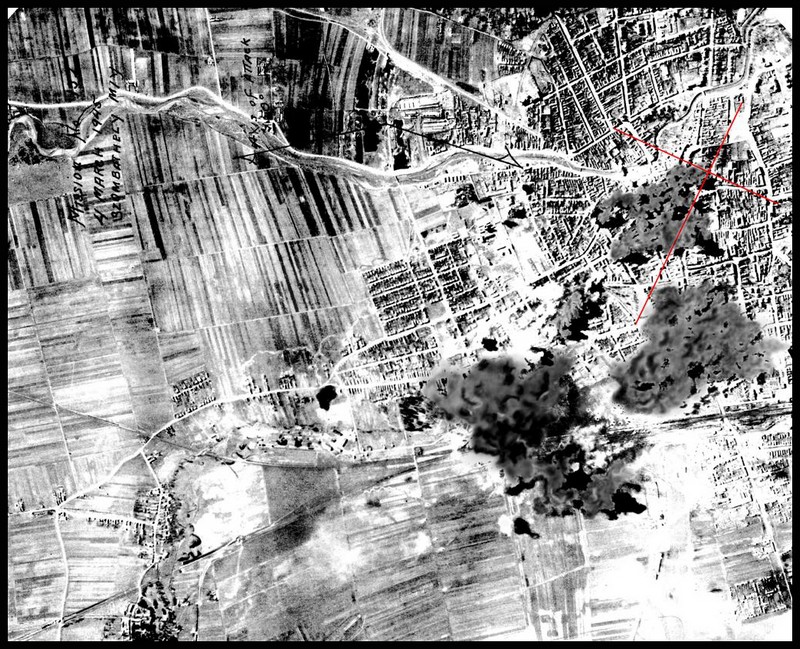
The moment of destruction of the Cathedral on March 4, 1945, Szombathely, Hungary (at: 12:42 pm, 485th. Bomb Group, 15th. Army Air Corps (Italy), Mission #152, 208 RDX bombs from 26 aircraft in the sky overhead).
(Photo Credit: U.S. Army Air Force Historical Research Center, Maxwell A.F.B., Alabama, USA)
The above image shows the moment that the Cathedral was hit on a bombing run over the city in 1945. The clouds of destruction boiling skyward have been changed to black and grey rather than “white” as shown in the original photograph. One small single cloud was left “white” with its corresponding shadow attached near the bottom. The red cross was added in by this author using corners of the streets in the city on a street map. The intersection of lines is the Cathedral. Time: 12:42pm. Upper left hand corner of this image contains tagging and two arrows that were added by the U.S. Army Air Corps back at the base following the mission this day.

The above image is an enlargement of an aerial photograph taken late in 1944. The reflection of the pavement at the Főtér, the “half” roof reflections of sunlight this late afternoon, is most notable on the roof of the Bishop’s Palace, the Cathedral, and the Seminary adjoining. Roof areas that did not reflect sunlight remain black and would then blend in with the shadow areas adjoining on the ground. The red square is the Cathedral. Possibly a reconnaissance photograph in advance of March 4, 1945.
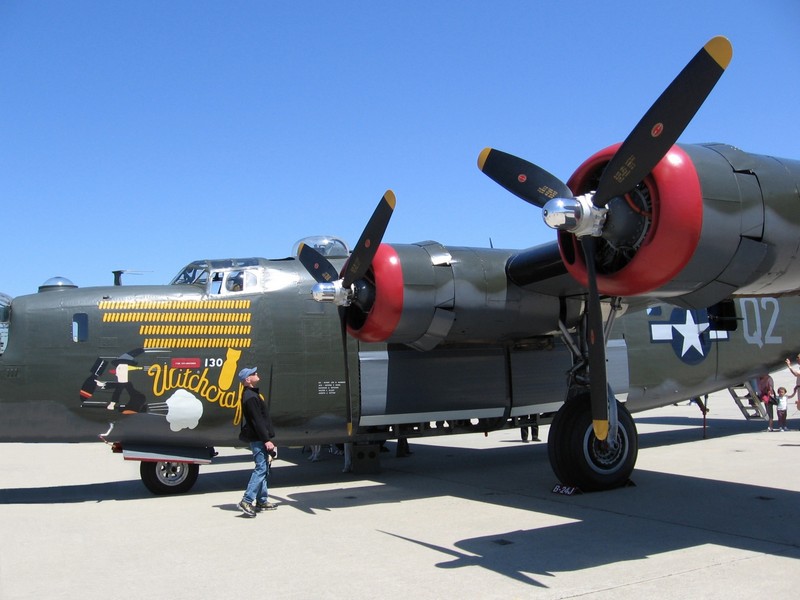
Over fifty years ago, in August 1944, the Collings Liberator was built at the Consolidated Aircraft Company’s Fort Worth, Texas plant. Shortly afterward, the aircraft was delivered to the US Army Air Force and in October of 1944, it was transferred to the Royal Air Force. Under the British flag, the B-24 saw combat in the Pacific Theater in operations ranging from anti-shipping to bombing and re-supply of resistance force operations.
At war’s end, the aircraft was abandoned by the RAF in a bomber graveyard in Khanpur, India; with the assumption that it would not fly again. However, in 1948, the Indian Air Force succeeded in restoring 36 B-24’s, including 44-44052, to operational status. These aircraft were utilized until 1968.
For the next 13 years, the aircraft sat abandoned in India until British aircraft collector, Doug Arnold, obtained it in 1981. The aircraft was disassembled and transported back to England in a Heavy Lift cargo plane. Once in England, the aircraft was advertised for sale in “as is” condition and in 1984, Dr. Robert F. Collings purchased it. After a sea voyage of three weeks, the B-24 arrived in Boston and was brought to Stow, MA in four truckloads.
Collings said that the Foundation intended to restore the plane for static display only, but he was persuaded to restore it to flying status by local B-24 crewmen. “This made it about a five times greater project,” Collings said. “We were convinced by the argument that only about three thousand people a year would see a static display, but three million might see it on a nationwide tour.
Preliminary restoration work started in 1985, led by Massachusetts volunteers, most of whom were former crewmen, or sons of crewmen, on B-24’s. When Collings decided to make the plane a flying restoration, he contacted Tom Reilly Vintage Aircraft in Kissimmee, FL to do the work on the airframe and powerplant. Volunteers restored the turrets, armament, radios, oxygen system, and cosmetic details. The original builders sponsored work on the Emerson Electric nose turret, PPG Industries of Pittsburgh supplied turret glass, and United Technologies of Hartford, CT donated a Norden bombsight. General Dynamics, a successor to Consolidated Aircraft, the original manufacturers of the B-24 in Fort Worth, TX, was a major sponsor of its restoration.
Collings said the restoration involved complete disassembly of the plane and work on about 80% of the B-24’s 1.2 million parts. There was some corrosion and minor damage “plus the desire to make all the systems (engines, props, hydraulics, and electrical) one hundred percent right”.
The entire hydraulic plant was replaced or overhauled, and every pulley was replaced. All cables and hardware, the bearings, an electronic strobe system, the batteries, and the radios were donated, along with installation advice and assistance.
The fuselage was in reasonably good shape, but twenty percent of its skin still had to be replaced. More than 420,000 rivets were replaced, as well as fuel cells, brake tubes, tires, and windows. Most of these parts were donated.
On September 10, 1989, after more than five years of hard work and 97,000+ hours of labor, the B-24 flew for the first time after restoration.
Starting a new life in 1989 flying as “All American,” a 15th Air Force aircraft, that flew in Italy with the 461st Bomb Group, the B-24, flew for many years with this scheme. In 1998, she was repainted to represent the “Dragon and His Tail” a 5th Air Force B-24 flying in the Pacific Theater with the 43rd Bomb Group. In 2005, she was repainted as “Witchcraft” in honor of the veterans of the 8th Air Force, who flew in the European Theater during WWII.
The history of “Witchcraft” is a story that legends are made from. The original “Witchcraft” was produced as a B-24H, built by Ford at the famous Willow Run, MI plant in 1944. It was delivered to the 467th in Wendover, Utah and initially assigned to Second Lieutenant George W. Reed and his crew who flew the aircraft to England. “Witchcraft” safely arrived with her crew at Station 145 in Rackheath, England on March 19th, 1944, after a 20-day flight over the Atlantic. The aircraft and crew began their combat service on April 10th, 1944, flying the first combat mission of the 467th Bomb Group. Over the next year “Witchcraft” flew an incredible 130 combat missions with various crews. “Witchcraft” was never once turned back while on a mission, and never had any crewmen injured or killed. Her last mission was flown on April 25th, 1945 which also was the last mission flown by the 467th Bomb Group. “…Witchcraft” was there at the beginning and at the end.” After the war, she was returned to the United States and like many other B-24’s, was scrapped on October 3rd, 1945 at the surplus depot in Altus, Oklahoma.
The B-24 flies as part of the Wings of Freedom Tour, visiting over 120 cities nationwide annually with the B-17 Flying Fortress and B-25 Mitchell. To accomplish this, the Collings Foundation relies solely on contributions and donations to cover the operating cost of over four thousand dollars per flying hour. These contributions ensure the future of the aircraft and keep it flying as a symbol of American patriotism and as a learning tool for our future generations to learn more about World War II and aviation history.
Specifications and History from the Collings Foundation Website.
The crews and images of “Witchcraft” during the war are from the 467th B. G.
Links below:
Color Photography (in the following section) is by the Author on location at Moffett Field (former Naval Air Station), Mt View, California. Runways and associated support services are also used by: N.A.S.A., Google Inc., Lockheed Missiles and Space, and Ames Research with its associated wind tunnel, all adjoining aircraft areas.

Note the five “hooks” on the right bomb rack. All four bays of the aircraft were configured the same and could carry up to 20 bombs depending on the size and weight of the ordinance mix. With the Bomb Bay doors open, extensive hydraulic tubing can now be seen and any severe damage from Anti Aircraft bursts would be fatal to the aircraft.
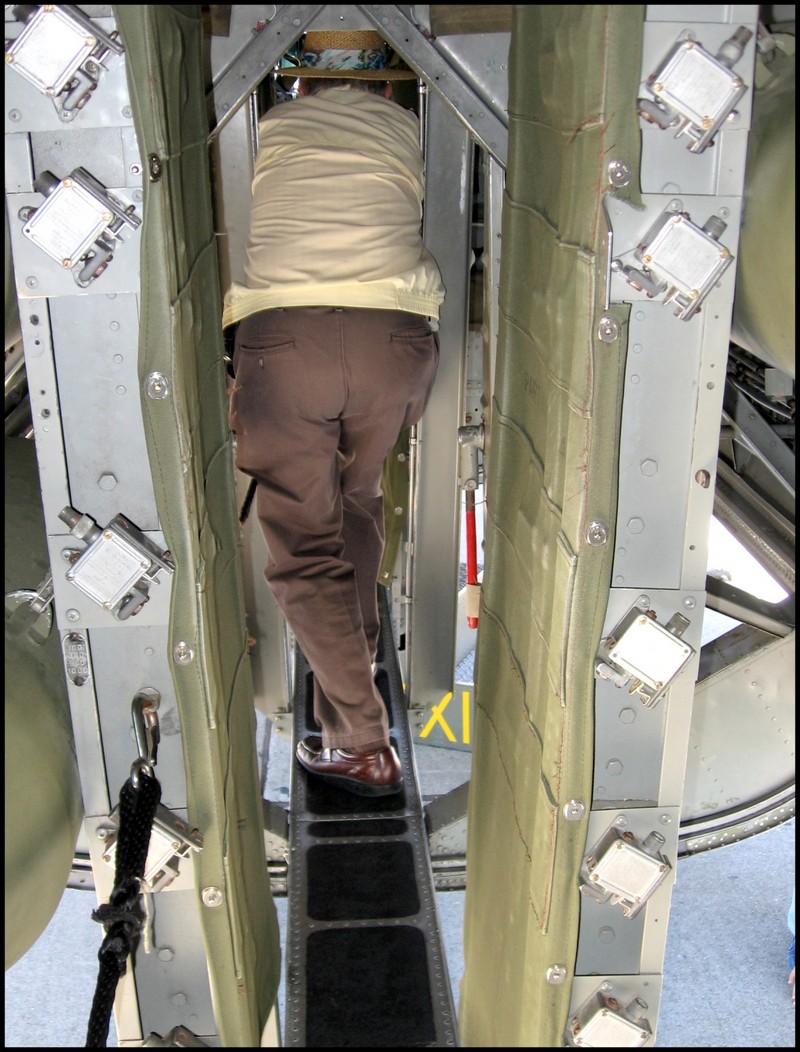
The four Bomb Bays can now be visualized as the gentlemen ahead of me squeezes through the bomb racks ahead. Now one can see why “gunners and ordinance men” tended to be thin and short in stature. Note the 500 lb. bomb located at the lower left hanging in its shackle.

These empty casings have been repainted with bomb fins attached. Note the dummy fuse on the lower bomb and the “stenciling”. Sometimes, word “art” may have been added to bombs, but the long hours and routine of war, provided little time for sleep. Aircraft “Nose Art” and the missions “bombs” in the aircraft however, were the few exceptions.

Looking forward into the Flight Deck w/ Radio and Navigation Desk at right.
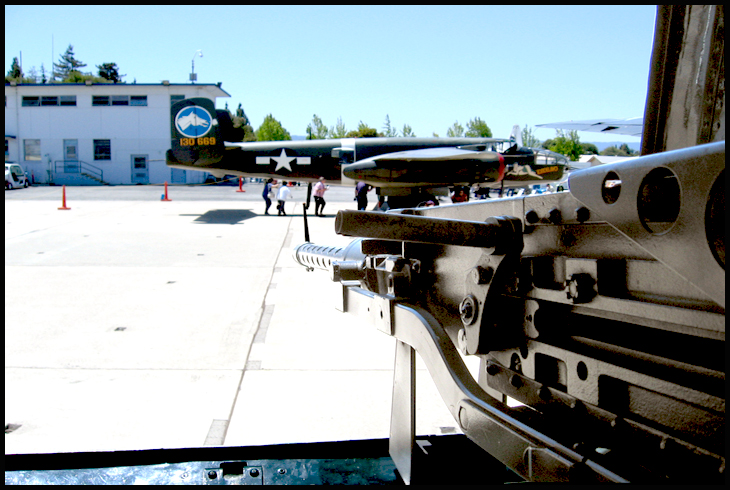
50 caliber Waste Machine Gun with a working (2 eng.) B-25 next door.
B-25s were also used from Naval Carriers at sea (see the Doolittle Raids).

Norden Bombsight used by bombing aircraft in WW2.

50 Cal. Waste Gun, Ammo Storage Box, and Belly Gunner “removal access panel” marked with ‘X’ at the lower left corner. Oxygen Tanks in yellow.

Pilot’s Position (above) and Center Flight console (below).


Co-Pilot’s Position.

Tail Gunner’s Turret

A very rare document called the “Flimsy” from WW2. All documents were prepared on manual typewriters, using tissue like paper, interwoven with carbon paper. These packets were then typed up by a “Typing Pool” before the 5am breakfast and were then handed out at the day’s “Mission Briefing” before dawn. Every Pilot, on every Bombing Mission for every Bomb Group that flew throughout the war, all received a copy with the Mission Orders packet. The above was dated: Oct 4, ’44, 8th Air Force flying B-17s out of England. Mission was scrubbed due to bad weather.